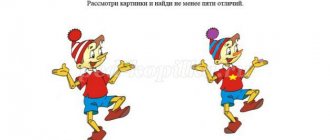Computer educational games for preschool children article on computer science on the topic
Slide 1
Computer didactic games in mathematics for preschool children The presentation was made by: 3rd year student of group DO Z - 432 of the Faculty of PiMDNiDO Shutko Veronika
Slide 2
A pronounced trend in the development of modern society is its informatization, accompanied by an increasingly widespread and intensive introduction of information technologies into various spheres of human activity. Just three decades ago, it seemed that the computer was a complex and mysterious device of the distant future, accessible only to a select few. And today, thanks to its versatility, it is useful to a person of any profession. It is the versatility of computer tools that determines their developmental effect in education. Introduction
Slide 3
The computer can be used not only as a practical aid in computer science lessons, but also as a means of expanding the capabilities of the educational process in all educational institutions from kindergarten to school. Children's interest in computers is enormous, and it is up to adults to create conditions for its maintenance and expansion in order to develop and improve the child's cognitive abilities.
Slide 4
If you have poor eyesight, you can only use glasses to use a computer; Maintain a distance from the eyes to the screen (50-70 cm); Take breaks from work and do eye exercises every 10-25 minutes of working in front of the monitor; Maintain correct working posture; Do not work on the computer in the dark; Monitor the content of games and programs; After exercise, wash with cool water. 7 basic rules when a child works at the computer
Slide 5
Computer games are special computer programs that display a picture on the screen, thereby turning this screen into a game field. It's a kind of "board game", but an impressive one and quite challenging. The truly gigantic number of games, the range of which is updated almost monthly (if not weekly), can confuse any of us. And knowledge of the genre classification of games will help us in this matter. Conventionally, the entire variety of computer games can be classified as follows: Games for preschoolers
Slide 6
Arcade games (arcades) are the most popular children's flash games with a fairly simple game plot. Children need to react quickly enough to changing situations. Children play, earn points, and gradually move to new levels. If a child completes the levels within the prescribed period, he will be awarded bonuses in the form of points, weapons and other options for completing them. Also, a young player, if he successfully completes all levels, gets into the gallery of the best participants in the game, where he can enter his own name. Arcades develop the speed of the thought process and reaction. Arcade games
Slide 7
Creative games include numerous educational computer games in which the child needs to complete all sorts of creative tasks: decorate objects, find several identical objects, find several differences between two seemingly identical pictures, and solve other interesting tasks. Such games provide an opportunity to reveal a child’s creative potential at a very early age. Programmers from the most famous software companies are working on new games. Creative games
Slide 8
In games of this genre, the player has at his disposal a small squad of characters, each of whom performs their own separate role or function. The goal of the heroes is to work together to explore the virtual world and complete the task. The task may be to find a specific treasure, treasure or spell. The path to achieving the intended goal is usually blocked by various obstacles and pests of various stripes, which must be overcome by force or cunning. This is where the main principle of a role-playing game comes into play - using the right character at the right time and in the right place. Role-playing games
Slide 9
The quest genre involves performing significant mental tasks during the game. Through logical thinking, the child plays out certain game situations. In order to successfully perform mental work, a child must concentrate and remember basic mathematical rules: multiplication, addition, subtraction, division. By alternately completing the appropriate tasks as the game progresses, the child gradually moves towards the end of the game, where bonuses or an interesting cartoon await him for successfully completing the game. Quests
Slide 10
Most children of older preschool age are interested in puzzles, if, of course, they are accessible to them. The usefulness of logic games is that they develop logical thinking skills. Most often, such a game is a single task or a set of several puzzles that need to be solved. Typical representatives of this genre are various tasks involving rearranging figures or composing a picture. Recently, Russian manufacturing companies have been producing many high-quality, varied logic games designed for preschool age, with the goal of teaching children counting, reading, writing and other subjects. brain teaser
Slide 11
developing the child’s logical thinking and memory; improving coordination of movements (fine motor skills); developing numeracy and reading skills; developing imagination and three-dimensional perception; developing the child's artistic taste and musical ear. There is also another classification of children's games:
Slide 12
preparation for school; the child, controlling the educational game program, begins to think first and then act; involvement in research work; the child’s social adaptation to school, his relationships with future classmates. How computer games can help:
Slide 13
Games for preschoolers: what to look for? Why is it important? Is the selected game suitable for age requirements? It is possible that games for preschoolers 5-6 years old may be suitable for a 4-year-old child - and vice versa. Try to review the game yourself before recommending it to your child. What skills and abilities will this game contribute to the development of preschoolers? Games for preschoolers can contribute to the development of fine motor skills, observation, and eye; logical, spatial, creative thinking. At the same time, the graphic and musical design of games for the development of preschoolers can be in no way inferior to computer “entertainment” games. Will the child be able to play this game with other children? Online children's games usually include multiplayer play and socializing features. How long will the chosen game be relevant for the child? Children's curiosity needs constant feeding. But educational games installed on a computer do not update themselves. In children's online games, new educational games for preschoolers are usually added by the developers themselves.
Slide 14
Purpose of the game: -to strengthen counting skills within 10 in children aged 5-7 years; -develop the ability to establish a correspondence between the number of objects and numbers; - develop attention. Progress of the game: An adult asks the child: “Name the fairy-tale characters. What fairy tale (cartoon) are they from?” Introduce children to the game task: “Count the fairy-tale characters and find the number that corresponds to their number. Click on the number. If you find the number correctly, it will move to the square with a question mark, which is located next to the fairy-tale characters. Click on the arrow to go to the next slide." Interactive game for preschoolers “Find the number” (5-7 years old)
Slide 15
Purpose of the game: - consolidate knowledge about geometric shapes: circle, square, triangle, rectangle, oval; -clarify children’s ideas about color; - develop observation and attention. Progress of the game: Read the poem to the children: Master, master, Help - The boots are leaky. Hammer the nails harder - We'll go visit you today! B. Zakhoder Introduce the game task: “Help the master fix his leaky boots. Choose your own patch for each boot. To do this, click on the patch, which is shaped like a hole in a boot. Be careful!" Interactive game for preschoolers 4-6 years old “Pick up a patch”
Slide 16
children can already complete tasks consisting of several stages; children already know how to concentrate on a task that interests them; Children’s hand motor skills are already well developed; children already have certain ideas about the world around them: people, animals, natural phenomena. When organizing classes for the preschool development of a child aged 5-6 years, it is worth considering that usually at this age... children can already write numbers and letters; children are already able to tell stories and poems expressively; children are already well oriented in space and time; Children already know a little how to classify objects, their eye and observation skills are actively developing. When organizing classes for the preschool development of a child aged 4-5 years, it is worth considering that usually at this age...
Slide 17
Goal: Development of logical thinking, attention, memory. This game will help preschoolers learn to reason and draw conclusions. Because it is important not only what the child chooses, but also how he explains his decision. Progress of the game: Guys, now you will see four cards with objects drawn on them. Three objects can be combined according to some characteristic, for example, shape or color. And one of them does not have this characteristic and is superfluous. In this game you need to find a card with an extra item and explain your choice. By clicking the mouse, the next slide will show a picture with the correct answer. Didactic game "Fourth odd". Logic and thinking game
Slide 18
The use of computer games in pedagogical practice is a way to improve the entire pedagogical process, increase the child’s education, it helps in diagnosing development, solving problems of correctional and developmental education, developing children’s initiative and curiosity; expanding the possibilities of creating elements of a developmental environment, expanding the possibility of implementing an individually differentiated approach to the child and creating a positive emotional background. Conclusion
Stages and methods of organizing computer games with preschool children
Definition 1
A computer game is a computer program that serves to organize the game process, communicate with game partners, or itself acts as a game partner.
When organizing games for preschool children, it is necessary to remember that traditional games are the driving force in the development of the child. It is impossible to replace a computer game, a game with a toy. Traditional games, unlike computer games, teach children to interact with each other, influence imagination, thinking and memory, and contribute to the mastery of gaming skills. Computer games do not have such developmental potential, which is why it is important to competently approach their organization in the preschool period of childhood.
Are you an expert in this subject area? We invite you to become the author of the Directory Working Conditions
Introducing children to computer games should be carried out in stages and ensure an organic relationship between different types of children's activities. A computer game promotes the development of cognitive activity in children, teaches them to set and solve various game problems, and independently develop the plot of the game.
Note 1
The leading method of organizing computer games for preschool children is the complex method.
The complex method consists of a number of interrelated components:
- The source of play is active knowledge of the surrounding world.
- Gradual development of gaming culture.
- Introduction of various problem situations that are created through the modernization of the subject-game environment and the organization of problem communication.
The main source of any children's game, including computer games, is the child's unique experience. With its help, he not only develops the game, but enriches his impressions of the world around him, people and relationships. In this regard, group games are very important for the development of children, since by interacting, children exchange their experience and knowledge. An experienced teacher is able to naturally and unobtrusively translate a variety of children's experiences into a game, including a computer game.
Finished works on a similar topic
Course work Organization of computer games with preschool children 470 ₽ Abstract Organization of computer games with preschool children 260 ₽ Examination Organization of computer games with preschool children 190 ₽
Receive completed work or specialist advice on your educational project Find out the cost
The experience that children gain from computer games is transferred to real life, where children independently develop it and learn to apply it in everyday life.
Note 2
Thus, one of the main conditions for organizing a computer game with preschool children is to enrich the gaming experience of each child through the educational content of the game.
Computer didactic game as an effective tool for increasing students’ interest in mastering new knowledge
Children are naturally inquisitive, they want to explore the world, they are able to consider serious issues and put forward original ideas. A computer didactic game will help you use this feature for the benefit of the educational process.
Using didactic games as a teaching method has several advantages. So, on the one hand, a specific didactic task is solved, that is, new material is studied, the material covered is repeated and consolidated, skills and abilities are formed that allow the acquired knowledge to be used in practice. On the other hand, didactic games are aimed at developing such personality qualities as observation, attention, and memory. The development of thinking also occurs, and it is possible to identify the creative inclinations of schoolchildren.
Didactic games also include computer games that are aimed at achieving a specific educational goal. The peculiarity of such a game is the presence of a computer player, who acts not only as the student’s opponent, but is also responsible for simulating the game situation and exercising control over the course of the game.
In order for a computer game to be classified as a didactic software product, its examination is carried out, during which the following areas of the gameplay are assessed:
- the idea of the game. In particular, the ideas, principles and values that underlie the game are assessed, and its goals and objectives are examined;
- ideas about the results, that is, it is necessary to evaluate what educational, developmental and educational effect can be achieved during the game;
- system for evaluating gaming results;
- simulated game situations;
- player behavior modeling.
In addition, when developing criteria for evaluating a didactic computer game, it is necessary to take into account provisions in the field of informatization and software quality management. At the same time, we must take into account that educational and computer technologies are constantly being improved and new methods and forms of gaming activities are emerging. In this regard, the proposed list of criteria is not complete and can be supplemented with other evaluation criteria.
These criteria can also be used as criteria for assessing content and didactically significant components that allow one to evaluate the capabilities of the information technologies used.
These criteria include:
- Playability or motivational component. It is aimed at maintaining the child's interest in the game and attracting his attention to the most important moments of the game. Using this criterion allows us to understand what stimulating effect the game has and how it affects the emotional state of the student.
In general, the game form of presenting material has a number of undoubted advantages:
- The idea of the game itself is attractive to audiences of all ages. And due to the fact that the game contains objects that are understandable to every student and takes into account the age of the children, it is possible to attract almost all students in the class to the game;
- activation of cognitive activity, however, for this, schoolchildren must be given the opportunity to independently manage the game situation and choose the optimal mode of activity;
- creating a favorable psychological atmosphere for accepting new material, since the game process itself contributes to the creation of a positive emotional mood;
- There is an assessment of the player’s actions, which is important for organizing the connection between the gaming environment and the player. With the help of one or another assessment, the player receives information about the correctness and effectiveness of his activities during the game, as a result of which a positive assessment helps to maintain genuine interest in the game itself.
- Content component. The applied indicators of this criterion are aimed at assessing the quality of the components through which the game world is modeled:
- the level of aggressiveness of the gaming environment towards the player. This parameter is needed in order to understand whether the game has any negative impact on the child’s psyche. For this reason, it is necessary that the game does not allow situations that could have a destructive influence;
- The goal of the game should be to achieve specific learning skills and abilities. This is precisely the main difference between a didactic computer game and a classic game, which is created solely for entertainment purposes;
- With the help of gaming material, a specific didactic task must be solved, therefore it is necessary to adequately assess the quality of the material used. It is also necessary to look at the degree of loading of the gaming environment with various game actions and objects, because their number should not affect the achievement of the set educational goals;
- the rules for changing the conditions of the gaming environment must be clear to the player, which will significantly reduce the time required to achieve the designated result. In addition, if the player understands what is required of him, then this contributes to the emergence of positive motivation, and the proposed game material does not cause rejection or rejection in him;
- The player is given clear instructions on the purpose of the game and the conditions upon which the game will be completed. With the help of these instructions, an operational game plan is drawn up, they also determine the player’s ability to understand what else needs to be done to achieve the game goal;
- the expression of educational and gaming actions is carried out in one operation. In a didactic computer game, the expression of educational actions is carried out through game actions. In most cases, they include indicative, informational, controlling and executive components.
- Procedural component. This component includes indicators that are used to characterize the game process and the organization of the player’s interaction with the gaming environment:
- the player has at his disposal the necessary means to change the game environment. This is achieved due to the interactivity of the game and the availability of a choice of several options for the content of the material being studied, as well as the ability to directly influence the game process by changing the parameters of the game environment or by changing individual elements of the game;
- the gaming environment changes in accordance with the command given by the player;
- at any time the user can receive objective information about the current state of the game. This means that the player is provided with detailed information about the number of points scored, the progress of the educational game task, the probable directions of development of further events, as well as the conditions for completing each stage and the entire game as a whole;
- the ability to interrupt the game at any time. This option should be provided in any game, which is required to comply with sanitary and hygienic rules, as well as to prevent the student from developing a gaming addiction;
- the ability to set the pace of events. Using this indicator, the complexity of the game is determined, which, in turn, determines playability and the ability to individualize the learning process;
- recording all user reactions during the game, which allows you to evaluate the level of interactivity of the gaming environment.
- Regulatory component. To evaluate this criterion, a set of indicators is used that regulate the player’s actions:
- the player has the opportunity to familiarize himself with the rules of the game at any time. This option allows you to relieve the player’s psychological tension and exercise control over his actions during the game;
- if there are difficulties, the player can receive the necessary advice. This indicator determines the efficiency of the assistance system;
- During the game, the player can receive the necessary instructions. At the same time, the main task of the help system is to remind, provide advice or lead to the right idea. It is also necessary to provide for the possibility of breaking the game process into several stages, which allows the student to develop the ability to act according to the algorithm;
- the presence of a registration system, which implies the possibility of dividing the game into several stages or the possibility of several people participating in the game at once;
- automatic recording by the system of the point at which the player paused the game. This point allows the student to return to the game to the place from which he exited. In addition, this function allows the teacher to track what stage the student is currently at;
- providing the student with sufficient time to complete all game actions. Therefore, educational computer games are developed in such a way as not to limit the player’s time, and screens are changed only after certain user commands. This approach involves taking into account the time it took the student to complete the entire game.
Basic criteria for assessing the content of didactic computer games
This group of criteria is used to assess the content of the gaming environment and individual gaming objects (the assessment is carried out from the point of view of the didactic value of the objects).
- Pedagogical expediency. The indicators used allow us to assess the possibility of achieving the set educational goals in the process of mastering the content of didactic computer games:
- During the game, the student can apply previously acquired knowledge and skills. The indicator is used to determine the didactic value of the game;
- When game goals are achieved, the set educational goals are simultaneously achieved, which makes it possible to evaluate the level of effectiveness of the game.
- Availability of methodological apparatus. This criterion is used for competent organization of the learning process using didactic computer games:
- availability of methodological recommendations. The indicator is used to assess the quality of the game, since it is important for both teachers and parents to have objective information about the limits of applicability of a didactic computer game;
- completeness and accessibility of teaching materials.
- The emotional intensity of the game. The criterion is used to characterize various aspects of the game related to the emotional experiences of students:
- the game does not contain harshness, violence and complies with moral and ethical principles;
- The player's loss can only be explained by the fact that he did not fully understand the game. Therefore, the game does not allow the creation of situations where the player may need new knowledge. At the same time, the player must be confident that he can cope with all the tasks offered in the game;
- using a variety of options for demonstrating “right/wrong” reactions.
- Achieving the intended training effect:
- the game must correspond to the topics being studied within the school curriculum. At the same time, it should be possible to simulate the same situation in different ways;
- a didactic computer game should ensure that children develop the ability to make the optimal decision in a certain situation, as well as ensure the development of thinking;
- through a game task, a didactic task is set;
- children’s play actions are determined by play and didactic tasks, as a result of which the game allows them to divert children’s attention from solving the main educational task;
- the presence of feedback, which presupposes that the student has the opportunity to independently assess the correctness of his actions and exercise control over them;
- the game involves the student using only the knowledge that he previously acquired while studying the school curriculum;
- The content of the game has a four-component structure, including indicative, informational, controlling and performing components.
- Game interactivity. This criterion includes indicators that characterize the level of independence of the player during his contact with the game:
- the ability to influence the gameplay by changing individual elements and parameters of the gaming environment;
- the ability to organize direct control of the actions of game characters.
The use of computer didactic games in the educational process helps to create conditions for the development of positive motivation for educational activities, the manifestation of conscious interest in educational activities, and is an incentive for the development of new knowledge.
Literature.
- Abdulmenova Z.Z. Play is a way to develop inquisitiveness and curiosity // Primary school. 2003. No. 11
- Amonashvili Sh.A. Development of cognitive activity of students in elementary school. / Questions of psychology. - 1984. - No. 5. - P.36-40.
- Belavina I.G. Child’s perception of the computer and computer games // Question of psychology. – 1993. – No. 3.
- Gramolin V.V. Educational computer games // Computer science and education. – 1994. – No. 4.
- Markova A.K. Formation of learning motivation at school age: A manual for teachers. – M.: Education, 1983.
- Mironova R.M. Play in child development. — Minsk, 1989
- Sidenko A. Game approach to teaching // Public education. 2000, No. 8 – 352 p.
- Elkonin D.B. Psychology of the game. – M.: Pedagogy, 1978.
“Computer games in the preschool education system”
Today, in modern society, computers and other gadgets have firmly taken their place. Numerous educational computer programs for preschool children not only allow them to gain knowledge in various areas, but also develop the ability to work with the computer itself from an early age.
In the modern world, computer games are considered an effective means of children's development. Unlike other types of games, they give you the opportunity to see the product of your imagination and your game. Computer games for preschoolers, like any other game, are based on a gaming task, which includes a goal, motive, methods and solutions.
Many scientists believe that the development of computer games can serve the further progress of humanity. They say that such games are able to actively interact with a person, because the child becomes a true participant in what is happening. But there are still many questions about the benefits of computer games and what consequences can be expected from a child’s excessive involvement in such games.
After analyzing various literature on this topic, we can highlight the positive aspects of using computer games:
1. Develop attention and speed of action
2. Builds sense of purpose and focus
3. Allows you to simulate new situations, even from the future
4. Generate interest in new technology
5. Form psychological readiness to master computer literacy
Studies by various scientists say that children who play computer games gain confidence in their strengths and capabilities and become more independent in solving various problems.
However, along with the positive aspects, there are also negative aspects:
1. The child stops communicating with friends, playing sports, and creative self-expression
2. The content of computer games is often aggressive and cruel, which affects the emotional state of the child
3. A strict mode of interaction with the player (act at a pace determined by the program) The desire to win at all costs causes a state of nervousness and fear in children
4. Reduces the intellectual activity of children due to the fact that such games are purely entertaining in nature
If we talk about conclusions, then the use of this kind of computer games by preschoolers should be limited. Games that may be available to preschoolers should be carefully selected by adults.
Now there are many computer games that are developed jointly by programmers, psychologists and teachers. Such games take into account the age characteristics of children, their patterns of development, education and training. Such computer-educational games are divided into three groups:
1. Educational programs that help children learn letters, numbers, develop reading skills, basic mathematical concepts, etc.
2. Developmental programs that promote cognitive development
3. Diagnostic, which are used to identify the development of memory, attention, etc. in children
All these computer-based educational programs have the same characteristics as ordinary didactic and role-playing games, since they also have game tasks, actions and rules. However, the advantage of such games over regular games is that the computer's reaction is much higher than the reaction of people, which allows the child to regulate the pace of completing tasks himself.
Educational computer games are comparable to creative games. However, in computer games there are game actions with symbols, and therefore children use substitution and assign game meanings to abstract symbols. All this allows children to better understand the logic of events and respond adequately to them.
In order for the use of a computer to be successful, conditions must be created not only at home, but also in a preschool institution. Here we talk about the creation of computer and gaming complexes in preschool institutions. Such a complex should include a computer room, a room for didactic, role-playing, directing and other games, and a room for psychological relief. It is important to say that when organizing such a complex, the interests of the health and harmonious development of children should be taken into account. Also, a child care institution with such a complex must be staffed with teachers with special education.
So, computer games included in the system of regular games contribute to improving the education of a child’s comprehensively developed creative personality and provide a level of intellectual readiness for learning at school.
Bibliography
1. Leontyev A.N. Psychological foundations of preschool play
2. Novoselova S.A. preschooler's computer world
3. Vakhrusheva L.N. about the possibility of using computer games in kindergarten







